 |
|
Introduction
Since the chemical
variability of ocean island basalts (OIB) was described
in the 1980s, it has become clear that the Earth's mantle
is heterogeneous on small and large scales. In order
to explain the isotopic variability observed in OIB,
several distinct mantle "end-members" have
been proposed (e.g. DM, HIMU, EM1, EM2, FOZO
and C) [White, 1985; Zindler & Hart,
1986]. The term "end-member" (or "component")
implies a mantle reservoir or reservoirs with specific
isotopic composition, and implies two things:
-
Fractionation
of the radioactive parent/daughter ratio for different
isotopic systems (e.g. U/Pb, Th/Pb, Sm/Nd,
Rb/Sr, Re/Os etc.). Because of the extremely slow
diffusion rate in the deep mantle [Hofmann &
Hart, 1978],
this fractionation can happen only at shallow depth,
i.e., in the upper mantle or the crust.
-
Isolation of the
"reservoir" for a long period of time
(1- 2 Ga). This is necessary in order for the different
isotopic systems to evolve to the specific signatures
observed in the "end members".
In addition,
basalt generation from the mantle source implies:
-
The source material
must yield, by partial melting, the major- and trace-element
chemical composition observed in OIB. This limits
possible parent/daughter isotope-ratio fractionation
in the source and, as a result, the possible isolation
time interval required to generate the different
isotopic signatures.
-
Pure end-member
compositions are practically never observed in oceanic
islands, suggesting that several end-members must
be present in the source in order to generate the
isotopic composition range observed in the OIB of
a single island.
|
1.
Hypotheses for the origin of OIB
1.1 Ancient
recycled subducted oceanic crust model
The proposal
made more than a decade ago, that the variation of trace
element and isotopic ratios in OIB is related to the
recycling of ancient oceanic crust [Hofmann &
White, 1982] and pelagic or terrigenous sediment
assimilation [Weaver, 1991, Chauvel et al.,
1992], is now widely accepted. This model is popular
because:
-
The recycling of
oceanic crust through the mantle is a undeniable
fact;
-
The generation of
arc volcanism from the subduction and dehydration
of oceanic crust suggests major fractionation of
trace elements in the residual subducted oceanic
crust;
-
Positive Nb and
negative Pb anomalies are observed both in OIB and
in MORB. This suggests a link in the generation
of these two types of basalt;
-
The addition of
pelagic and terrigenous sediments to subducted oceanic
crust could explain the chemical and isotopic differences
observed between different end-members signatures.
Nevertheless, several chemical and physical arguments
suggest that subducted oceanic crust is not the source
of OIB [e.g. Sun & McDonough, 1989; Halliday
et al.,
1995. Niu
& O'Hara
[2003] state, provocatively:
"There
is no obvious association between ancient recycled oceanic
crust and OIB (mantle plumes) in terms of petrology,
geochemistry, and mineral physics".
This claim
is based on the following arguments:
-
Melting of oceanic
crust with basaltic or picritic composition cannot
produce the high-magnesian lavas that are parental
to most OIB. Primitive OIB melts (>15% MgO) are
probably more magnesian than bulk oceanic crust
(<13% MgO).
-
Oceanic
crusts subjected to subduction zone dehydration
reactions must be depleted in water-soluble incompatible
elements such as Ba, Rb, Cs, Th, U, K, Sr and Pb
relative to water-insoluble incompatible elements
such as Nb, Ta, Zr, Hf
and Ti, etc. Residual crust with such trace-element systematics is unlikely to be
the fertile source of OIB.
-
Ancient oceanic
crust is isotopically too depleted to produce the
isotopic signatures of most OIB. OIB Sr-Nd-Hf isotopes
preserve no signature that indicates previous subduction
zone dehydration histories.
-
Subducted oceanic
crust at shallow lower-mantle conditions form mineral
assemblages that are much (>2.3%) denser than
the ambient peridotitic mantle. If subducted crust
melts in the deep lower mantle, this melt, depending
upon its composition, may have still greater (up
to 15%) density than solid peridotitic mantle. Therefore
ancient oceanic crust that has subducted into the
deep lower mantle cannot return in bulk to the upper
mantle in either a solid or molten state.
1.2 The
problem of major element composition
In
addition to the problems highlighted by Niu
& O'Hara
[2003],
the question of the silica-deficient composition of
OIB was pointed out many years ago [Green et al.,
1967]. Many ocean island rocks are characterized by
silica undersaturated compositions (low silica and
high alkali contents), whereas the partial melts of
oceanic-crust lithologies produce silica saturated
liquids [Green
et al., 1967]. Partial melting of a mixture of
subducted crust and peridotite produced by mechanical
desegregation of subducted eclogite [Kogiso et
al., 1998],
or by hybridization of peridotite by partial melts
of eclogite [Yaxley & Green, 1998], generate
alkali glasses. But these glasses contain too high
Al2O3
and too low CaO to represent a potential source of
OIB. Experimental data indicate that partial melting
of peridotite in the presence of carbonate [Hirose,
1997] or silica-deficient pyroxenite [Hirschmann
et al.,
2003; Kogiso & Hirschmann, 2003; Keshava
et al., 2004] produces liquids which are close
to the nephelinite, basanite or alkali-basalt
major element compositions observed in OIB. Conversion
of silica-saturated MORB to silica-deficient pyroxenite
is possible, but requires either hybridization
with peridotite, metasomatism by silica-deficient
fluid such as carbonatite, or removal of low-pressure
partial melts or fluids in the presence of olivine
or spinel [Hirschmann
et al.,
2003, Lundstrom et al., 2000]. However,
the effect of these different processes on the
trace element budget of pyroxenites is not known.
1.3 An
alternative model for the source of OIB
Silica deficient pyroxenite veins could be produced within continental
or oceanic lithospheric mantle by percolation of magmatic
liquids generated at low degrees of partial melt (low
F) in upper-mantle rocks enriched in volatiles, alkali
and incompatible trace elements at the base of the lithosphere
[Sun & McDonough, 1989; Halliday
et al.,
1995; Niu et al., 1996; 1997; 2002;
2003]. As suggested by Niu
& O'Hara
[2003], this metasomatic
process could occur as oceanic lithosphere cools and
is transported away from the mid-ocean ridge. Subducted
oceanic basal lithosphere enriched by metasomatic veins
provides an alternative for the source of OIB. A similar
hypothesis for the source of OIB, based on a comparison
of OIB and MORB from the central Atlantic, was proposed
by Halliday
et al.
[1995]. They postulated that the source region of
OIB is enriched by small-degree partials melt soon after
formation of the oceanic lithosphere at the periphery
of plumes or at mid-ocean ridges. Metasomatism of the
uppermost mantle would generate a "near-surface
fractionated" (NSF) source with high U/Pb, Ce/Pb
whilst maintaining Ce/U relatively unfractionated. The
similarity of composition between basalt produced by
modest extension in continental regions and OIB led
McKenzie & O'Nions [1995] to propose that
the source of OIB could be delaminated, metasomatised,
continental lithosphere. As with models for metasomatism
of ocean lithosphere, metasomatism of continental lithosphere
implies the percolation of metasomatic melts rich in
volatiles and incompatible elements into lithospheric
mantle previously depleted by melt extraction [McKenzie
& O'Nions,1995].
The problem
with these various alternative models for the source
of OIB is that they do not explain:
- Why there are systematic
isotopic and trace element variations in the source
of basalt from a single island, and
- How metasomatism
can produce the apparent end-member mantle sources
of OIB.
Moreover, the
different mantle end-members (HIMU, EM1 and EM2), which
are defined by their isotopic compositions, are also
characterized by different trace-element ratios such
Nb/Th, Ba/Nb, Th/La [Weaver, 1991; Chauvel
et al., 1992]. In the recycled, ancient oceanic
crust model [Hofmann & White, 1982], these
elemental variations are related largely to the addition
and assimilation of recycled sediment to the recycled
oceanic crust [Weaver, 1991; Chauvel et al.,
1992]. In contrast, no clear model for the correlation
between trace-element and isotopic variations has been
developed for different metasomatic alternative models.
The Cantal
basalts from the Massif Central, France, have been interpreted
as the product of metasomatism within the lithospheric
mantle. This work provides new information that can
constrain the formation of distinct compositions in
lherzolitic OIB mantle sources. |
2. A source
for Cantal basalt involving veins plus enclosing lithospheric
mantle
2.1 Trace element variations in the
Cantal basalt source
The
basalts erupted between 13 and 3 Ma ago in the Cantal
alkali massif are similar to OIB in major and trace
elements composition (Figures 1 & 2) [Wilson
& Downes, 1991; Pilet
et al., 2002]. They present a substantial composition range, from alkali basalts
to basanites, which can be explained by a variation
in the degree of partial melting of a common mantle
source.
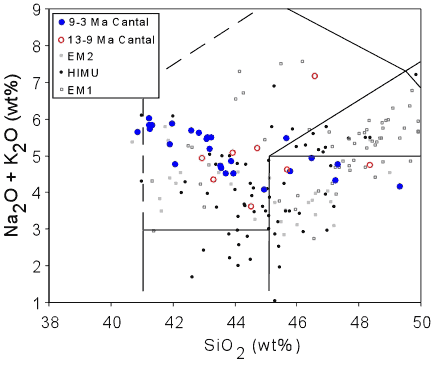
Figure 1: Total alkalis
vs silica diagram for 13-9 Ma and 9-3 Ma Cantal
basalts.
|
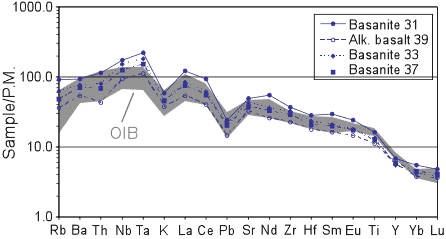
Figure 2: Primitive-mantle-normalised
trace-element variation diagram for typical
9-3 Ma Cantal basalts. Normalisation values
from McDonough [1995]. Grey field: OIB variation
range. The variation in the incompatible trace
element content in mafic Cantal rocks might
be explained by a smaller degree of partial
melting for basanites than for alkali basalt
in a common source.
|
With respect to trace element compositions, these basalts show an unusual
increase of Nb/Th and Ce/Pb ratios from 10.5 and 23
respectively during the first period of basalt eruption
(13-9 Ma) to 18.7 and 44 during the last period (9-3
Ma) (Figure 3). The ranges in Nb/Th and Ce/Pb encompass
practically all the variation observed in the major
oceanic islands [Halliday
et al., 1995; Jochum et al., 2001]. Moreover, Figure 3 indicates that the
first erupted Cantal basalts have similar Nb/Th and
Ce/Pb ratios as are observed in EM1, while the last
are similar to HIMU.
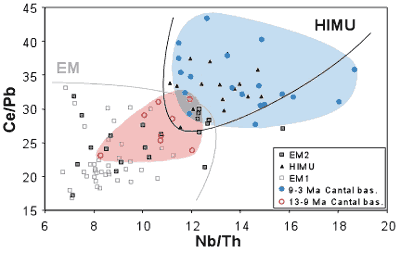
Figure 3: Ce/Pb
vs. Nb/Th diagram showing the variation between
the first (13-9 Ma) and last erupted basalts (9-3
Ma) in the Cantal Massif, together with the composition
of representative analyses from HIMU (Mangaia,
Rurutu and St Helena islands), EM1 (Rarotonga,
Tristan da Cunha, Gough and Pitcairn islands)
and EM2 (Tahaa, Tutuila and Upola islands) mantle
end-members. Data for these different oceanic
islands were taken from the GEOROC database (http://georoc.mpch-mainz.gwdg.de/georoc/Start.asp).
|
Variations
in Ce/Pb and Nb/Th in mafic rocks are generally attributed
to sediment assimilation in the mantle source [Weaver,
1991; Chauvel et al., 1992] or during passage
through the crust. However, the basalts are homogeneous
with respect to their Sr, Nd and Pb isotopic compositions
(Figure 4) and do not display any correlation between
Ce/Pb or Nb/Th and the Sr, Nd or Pb isotopic ratios
[Pilet
et al.,
2002; 2004].
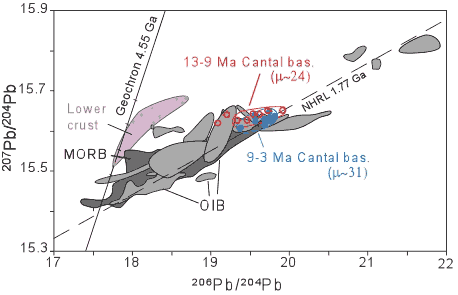 Figure 4: 207Pb/204Pb
vs 206Pb/204Pb diagram for
Cantal basalts together with a selection of oceanic
basalts. Dark grey field: MORB isotopic variation;
light grey fields: isotopic variations observed
in different oceanic islands [Zindler & Hart,
1986].
Figure 4: 207Pb/204Pb
vs 206Pb/204Pb diagram for
Cantal basalts together with a selection of oceanic
basalts. Dark grey field: MORB isotopic variation;
light grey fields: isotopic variations observed
in different oceanic islands [Zindler & Hart,
1986]. |
This implies
that:
-
Variable sediment
contamination of their mantle sources or crustal
assimilation can be excluded by the observed Nb/Th
and Ce/Pb variations, because a correlation between
isotope and trace element variation would then be
seen, which is not the case, and
-
The variation in
trace elements in the source reflects "short-term"
mineralogical control of trace-element ratios in
a vein-plus-enclosing-mantle source rather than
"long term" extraction of continental
crust from the mantle, sediment recycling and incomplete
homogenization of ancient heterogeneities in the
mantle.
This mineralogical
modification of the mantle source may result from the
metasomatic process "percolative fractional crystallization"
(PclFC) [Harte et al., 1993], which produces
veins in the upper mantle.
2.2 Mineralogical evidence for a PclFC
mechanism in the Cantal basalt source
The
PclFC mechanism results in clinopyroxene (CPX) xenocrysts
in the Cantal basalts [Pilet
et al., 2002; 2004]. These
xenocrysts have a compositional range from Ti-augite
with Mg# > 70 (Mg# = Mg/[Mg+Fe2+]) to
green aegirine-augite with Mg# < 50 (hereafter GCPX)
(Figure 5).
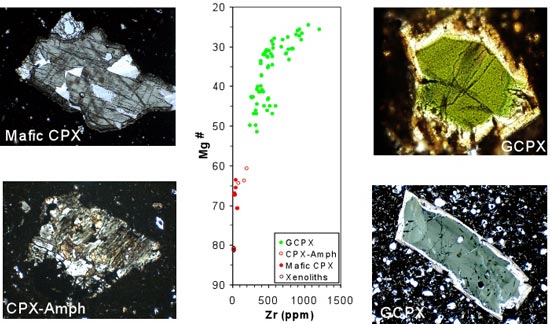
Figure 5: Mg# vs Zr diagram
for Cantal CPX xenocrysts. Photographs present
typical CPX xenocrysts from mafic (Mg# >70)
to differentiated CPX compositions (Mg# <50).
|
The GCPX are
interpreted as mantle xenocrysts because:
-
CPX
with compositions similar to Cantal GCPX is observed
in mantle veins from La Palmas [Wulff-Perderson
et al., 1999, Pilet
et al., 2002];
-
A fluid-inclusion
study performed on GCPX from Hungarian basalts [Szabo
& Bodnar, 1999] points to an upper-mantle
origin;
-
Sr, Nd, Pb and O
isotopic compositions of GCPX in continental flood
basalts from Yemen [Baker et al., 2000] indicate
the absence of crustal contamination during GCPX
crystallization and a direct relationship to an
asthenosphere-derived melts;
-
The observation
of mantle xenoliths in Cantal rock where GCPX are
observed excludes practically all possibility of
mixing in the lower crust to explain the presence
of the GCPX.
The trace
element variations in the different types of CPX
xenocrysts constrain the evolution of the mineralogical
and chemical compositions of veins during the
PclFC process (Figure 6). We observe, in Figure
6, first an increase in all trace elements with
a decrease of Mg# in CPX xenocrysts (type 1 to
type 2, Figure 6). This is explained by fractional
crystallization and by the increase in the Kd
Cpx/liq for the different elements
in differentiated liquid [Dobosi & Jenner, 1999]. CPX with lower Mg# exhibit distinctive primitive mantle-normalized
trace-element patterns. In the most differentiated
CPX composition (type 3 in Figure 6), we observe
a decrease in all trace elements except Pb and
Th. The decrease in all high-field-strength elements
(HFSEs) is ascribed to the fractionation and deposition
of Nb-rich rutile during the PclFC process which
generates the GCPX [Pilet
et al., 2004]. For all other elements, these decreases are related to the formation
of apatite which is frequently observed as inclusions
within the xenocrysts. The increase of Pb relative
to the other elements reflects differences in
distribution coefficients (Kd) for Pb and La,
Ce, Sr etc. in all phases that crystallized during
the PclFC process (Kdmin/liq Pb <
Kdmin/liq La, Ce, Sr etc. for CPX,
olivine, amphibole, phlogopite etc. [Halliday
et al., 1995]. |
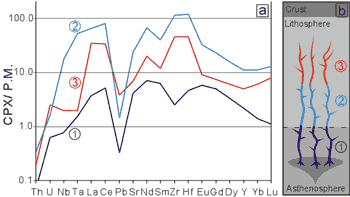
Figure 6: a) Primitive-mantle-normalised
trace-element compositions of CPX xenocrysts.
CPX with Mg# > 70 (dark blue line); intermediate
CPX composition (light blue line); differentiated
CPX composition (red line). The decrease in
Nb, Ta and REE from intermediate to differentiated
CPX is the result of fractionation and deposition
of Nb-rich oxides and apatite respectively in
intermediate veins. b) Schematic metasomatised
lithosphere. The evolution of CPX xenocrysts
reflects the evolution of different vein compositions
produced by the PclFC process (mafic, intermediate
and differentiated veins). Increases in Nb and
Nb/Th in intermediate veins are attributed to
the presence of Nb-rich oxide (rutile). Decreases
in Ce/Pb ratios in the differentiated veins
reflect differences in distribution coefficients
(Kds) for Ce and Pb in all phases that crystallized
during the PclFC process (Kdmin/liq
Ce > Kd min/liq Pb for CPX, olivine,
amphibole, phlogopite, apatite etc. [Halliday
et al., 1995]).
|
Following
these observations, high- and low-Nb/Th and Ce/Pb
ratios characterize the intermediate and differentiated
veins respectively. Pilet
et al.
[2004] postulated that the variation in composition
between the first and last erupted basalt is the
result of evolution of vein compositions present
at the depth of melting in the vein-plus-enclosing-lithospheric-mantle
source (Figure 7). Basalts erupted during the
first period of volcanism included differentiated
veins in their source whereas later ones tapped
intermediate veins.
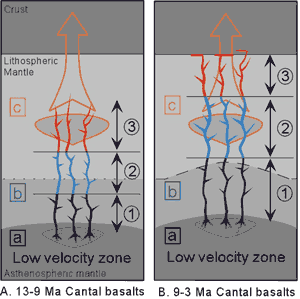
|
Figure
7: Schematic model for (A) 13-9 Ma and (B) 9-3
Ma basalt genesis. (a) Basaltic melts are produced
by partial melting in the low-velocity zone observed
below the European lithosphere [Granet et al.,
1995]. The low velocity zone is thought to be
rich in alkali, trace elements and volatiles [e.g.
Niu
& O’Hara, 2003]. (b) Rising melts
percolate along channels or pervasively through
asthenospheric and then lithospheric peridotite.
They undergo a PFC process, precipitating amphibole,
clinopyroxene, oxide, and apatite in veins. Three
main zones with different compositions are distinguished
in veins: (1) mafic pyroxenite veins; (2) differentiated
veins with clinopyroxene, amphibole, Nb- and Ta-rich
oxide (such as rutile), ilmenite and apatite;
and (3) veins extremely enriched in Th, U, and
LREEs relative to Ta and Nb, which are depleted
as a result of rutile fractionation. These latter
veins are composed of GCPX, apatite, amphibole,
ilmenite, and residual melts. Geochemical evolution
of the differentiated GCPX-bearing veins is similar
to that proposed by Bedini et al. [1997] to explain
evolution during the PclFC process. (c) Melt percolation
and vein deposition are associated with migration
of a thermal front across lithospheric mantle
[Lenoir et al., 2001]. Partial melting of veins
plus enclosing depleted lithospheric mantle forms
Cantal basaltic liquids. Because 13-9 Ma and 9-3
Ma basalts have similar major element compositions,
their depth of mantle melting must have been similar
[Albarède, 1992]. As PFC proceeded, vein
compositions at the depth of melting evolved from
type 3 during the early basalt activity to type
2 during the late basalt activity. |
2.3 Influence
of the enclosing lithosphere over the metasomatic process
The
mineralogical and chemical constraints described above
indicate that continental basalts with compositions
similar to OIB could be generated by melting veins plus
enclosing continental lithospheric
mantle. But does this model apply to metasomatic vein
formation within the oceanic lithosphere? Several lines
of evidence suggest that it does:
-
The
model suggests that the trace-element composition
of basalts is mainly controlled by the composition
of veins in the source [Pilet
et al., 2004]. This is because of the difference in the degree of trace-element
enrichment in veins compared to the surrounding
mantle. For example, concentrations of incompatible
trace elements are 40-80 times higher in vein minerals
than in lithospheric spinel peridotite minerals
(e.g., GCPX have 12-40 ppm of La whereas
clinopyroxene from depleted peridotite xenoliths
from the Massif Central contain only 0.3-0.6 ppm
of La [Zangana et al., 1999]). Thus the nature
of the enclosing lithosphere does not play an essential
role in the generation of OIB trace-element compositions;
-
Cantal lithosphere
has a depleted composition, which has been attributed
to the extraction of basaltic liquid from an initial
near-chondritic mantle source [Zangana et al.,
1999; Lenoir et al., 2000; Downes et al.,
2003]. Thus, before Neogene volcanic activity, Cantal
lithospheric mantle was similar to typical unmetasomatised
oceanic lithosphere;
-
GCPX xenocrysts
in alkali basalt are described from both oceanic
and continental settings [ Pilet
et al.,
2002]. This suggests that the PclFC process
is global.
Furthermore,
the PclFC process observed
in Cantal basalt sources can be linked with the low-F,
volatile- and incompatible-element-enriched, metasomatic
agent that seems to affect the oceanic basal lithosphere
[Halliday
et al.,
1995; Niu et al., 1996; 1997; 2002;
2003]. The similarities in the two processes
are:
-
Initial liquids
derived from the PclFC mechanism must be produced
at low F, i.e., the melt fractions must be
sufficiently large to segregate from the peridotitic
source but not so large that they are transported
out of the upper mantle into the crust.
-
The initial PclFC
model liquid must have high-H2O and CO2
contents, as demonstrated by amphibole inclusions
in CPX xenocrysts, carbonate in association with
GCPX in xenoliths
from Australian basalt [Wass, 1979] and CO2
fluid inclusions in GCPX from Hungarian basalts
[Szabo & Bodnar, 1999].
-
In both the continental
and oceanic environments, the initial metasomatic
model melt is generated in the low velocity zone
at the base of the lithosphere [ Pilet
et al.,
2004, Hoernle et al., 1995, Granet
et al., 1995, Niu et al., 2002;
2003].
|
3.
Evolution of metasomatised heterogeneous lithosphere
3.1 Trace
element variation within metasomatised heterogeneous
lithosphere
The compositional
differences between Cantal basalts erupted during the
two periods of volcanism provide an unusual opportunity
to characterize compositional variations introduced
by metasomatic processes in lithospheric mantle. As
indicated in Figure 6b, which is a schematic model of
metasomatized lithosphere, we distinguish upper and
lower parts of this hypothetical lithosphere. The composition
of the upper part is constrained by the composition
of first-erupted Cantal basalt while the lower part
is related to the composition of last-erupted basalt.
As shown in Figure 8, there are striking differences
between the two parts.
Figure 8:
Trace element variations observed between the
first (13-9 Ma) and the last (9-3 Ma) emitted
basalts in the Cantal Massif. Diagram normalised
to the average composition of the 9-3 Ma basalts,
measured at 9 ppm of Th, which accounts for differences
in degrees of partial melting. Light blue lines:
minimum and maximum normalised value of 9-3 Ma
basalt measured at 9 ppm of Th. Red line: average
and confidence interval of 13-9 Ma basalt. The
range of µ ratios measured in 13-9 Ma (30.3 -
42.8) and 9-3 Ma (38.8 - 53.0) basalts. Cantal
basalts may be used to calculate µ ratios of 24
and 31.2 in their respective sources. |
|
These differences
are particularly important for Ba, Nb, Ta, and Pb, yielding
an increase in U/Pb and Th/Pb. Smaller variations observed
for Sm and Nd are associated with a decrease in Sm/Nd
for early basalts relative to late ones. There is also
probably a decrease in Rb/Sr from early to late basalts
but this is less safe since Rb was mobile during alteration
of the 13-9 Ma Cantal basalts. The decrease in Rb/Sr
is inferred on the basis of (1) a decrease in Ba/Sr
between the two periods of basalt emission (Ba is generally
correlated with Rb in basaltic rocks [Hofmann &
White, 1983]) and (2) a decrease in Sr and an increase
in Rb content in the most differentiated veins. The µ
ratio average is estimated to be 31.2 in the source
of the 9-3 Ma basalt (with extreme values up to 37.1)
and 24.0 in the source of the 13-9 Ma basalt (with
extreme values up to 23.1). Analogous estimates for
147Sm/144Nd indicate 147Sm/144Nd
values of 0.144 and 0.153 for the first and last erupted
basalt respectively.
3.2 Temporal
evolution of the metasomatised heterogeneous lithosphere
Metasomatised
lithosphere could be entrained in asthenosphere flow
during subduction of the oceanic lithosphere or delamination
of the continental lithosphere. It would then become
a long-term heterogeneity producing isotopically enriched
mantle. We can model the temporal evolution of isotopic
systems in the enriched mantle.
The subduction
process generates a metamorphic transformation of vein
mineralogy and probably hybridization within the enclosing
mantle. However, because of the very low diffusion rate
at high pressure [Hofmann & Hart, 1978; Kogiso
et al., 2004], chemical heterogeneity will be preserved
within the subducted mantle lithosphere. Nevertheless,
during these processes, the enriched component will
be greatly diluted in a manner similar to that proposed
for enrichment by subduction of oceanic crust [Chauvel
et al., 1992], erosion/delamination of sub-continental
lithosphere [McKenzie & O'Nions, 1995] or
model NSF mantle recycling [Halliday
et al.,
1995]. It is extremely difficult to estimate the
dilution factor, but the average of the enriched component
calculated previously and the depleted mantle ( µ
DM = 10 and 147Sm/144Nd
DM = 0.21 [Rehkämper & Hofmann,
1997]) may be used for model evolution calculations.
Because
metasomatised lithosphere would be
heterogeneous with variable U/Pb, Th/Pb and Sm/Nd ratios,
different Pb and Nd isotopic ratios will be produced
in the upper and lower parts of the lithosphere. The
µ
ratio of the basal lithosphere would, after 1.77 Ga,
have a 206Pb/204Pb isotopic ratio
similar to that of the sources of HIMU basalts (Figure
9a). The absolute value of this isotopic ratio is highly
dependant of the estimate of the µ
ratio in the source, isolation time, dilution factor
and choice of initial isotopic composition which is
taken here to be similar to depleted mantle at 1.77
Ga or 1 Ga. Conversely, the difference in µ
calculated between the
lower and upper lithosphere (and in the corresponding
last and first emitted Cantal basalt) is better constrained
and varies linearly with the dilution factor or with
the method used to estimate the µ
value of the sources.
The different values of µ
produce 206Pb/204Pb
variations of ~1.2 over 1.77 Ga (Figure 9a) using the
average µ
values, and ~2.2 using
the extreme µ
values for the first (16.55, average of the value calculated
from Cantal basalts and µ
value of DM) and last
(23.55) emitted basalts. For an isolation time of 1
Ga, the 206Pb/204Pb variation
range calculated is somewhat smaller than, though similar
in scale to, that seen in individual oceanic islands
(~0.6 for average µ
values and ~1.9 for extreme µ
values) (Figure 9a).
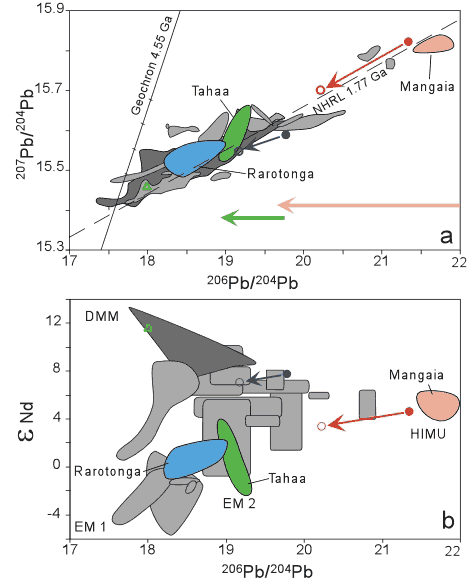
Figure 9: a)
207Pb/204Pb vs 206Pb/204Pb
and b) εNd (today) vs 206Pb/204Pb
diagrams for oceanic basalts. εNd
(t) = (143Nd/144Nd
(t,sample)/ 143Nd/144Nd
(t, CHUR) -1) x 104 with
143Nd/144Nd (today,
CHUR)= 0.512638. Red and blue points:
present-day Pb and Nd isotopic ratios generated
after 1.77 Ga and 1 Ga respectively from the
lower part (full point, μ ratio: 20.6, Sm/Nd: 0.289, see text for explanation)
and the upper part (empty point, μ
ratio: 17.0, Sm/Nd: 0.282) of metasomatised
lithosphere. Green triangles: isotopic compositions
of unmetasomatised lithosphere.
Arrows indicate the effect of evolution of the
metasomatic agent within lithosphere over the
isotopic composition after 1 Ga (blue) and 1.77
Ga (red). Dark grey field: MORB isotopic
variation; light grey fields: isotopic variations
observed in different oceanic islands [Zindler
& Hart, 1986]. Orange, green
and blue fields: Mangaia (Cook Islands) Tahaa
(Society Islands) and Rarotonga (Cook Islands)
isotopic compositions respectively. Data from
GEOROC data base (http://georoc.mpch-mainz.gwdg.de/georoc/Start.asp).
Orange and green arrows: 206Pb/204Pb
variation range in olivine-hosted melt inclusion
from Mangaia and Tahaa basalt respectively analysed
by Saal et al. [1998]. Direction of arrows reflect
a decrease in Cr content in CPX crystallized
in melt inclusion [Saal et al., 1998]. Model
calculation: unmetasomatised lithosphere is
formed at 1.77 Ga or at 1 Ga with initial Pb
isotopic ratios calculated using present-day
206Pb/204Pb and 207Pb/204Pb
of 18 and 15.46 respectively and with μ
ratio fixed to 10 [Rehkämper&
Hofmann, 1997]. The Nd isotopic composition of unmetasomatised lithosphere
at 1 or 1.77 Ga is calculated using a present
day 143Nd/144Nd value
of 0.5132 and 147Sm/144Nd
ratio of 0.21. [Rehkämper &
Hofmann, 1997] .
|
The combination
of µ and
Sm/Nd heterogeneities in Cantal basalt sources produces
variations in 143Nd/144Nd –
206Pb/204Pb that simulate mixing
between HIMU and EM components reported for OIB worldwide
(Figure 9b). The inferred high Rb/Sr in the upper part
of the hypothesised lithosphere relative to the lower
part would produce significant 87Sr/86Sr
variations with time in the derived basalts. This estimate
of 87Sr/86Sr variation is in agreement
with the apparent mixing trends between HIMU and EM
components inferred from 206Pb/204Pb,
207Pb/204Pb and 143Nd/144Nd
variations calculated from the upper and lower parts
of the heterogeneous lithosphere.
Isotopic
trends of Nd-Sr-Pb in oceanic basalts are correlated
with trace-element ratios that are used to infer
elemental signatures of the hypothetical EM
and HIMU end-member mantle components [Weaver,
1991; Chauvel et al., 1992] (Figure 3,
10a, 10b). As indicated in Figure 10, the variations
in trace element ratios from the first to the
last period of Cantal basalt emission define
a trend that mimics mixing between HIMU and
an EM component.
Figure
10: a) Ba/Nb vs La/Nb and b) Th/Nb vs Th/La
diagrams for Cantal basalts; 13-9 Ma (open red
circles) and 9-3 Ma (filled red circles) from
the upper and lower parts of metasomatised heterogeneous
lithosphere. HIMU (triangles), EM1 (filled squares)
and EM2 (open squares) compositions are from
Weaver [1991].
These data demonstrate that fractionation
of trace-element ratios (U/Pb, Th/Pb, Rb/Sr,
Sm/Nd, Nb/La etc.), necessary to generate EM
and HIMU isotopic characteristics over time,
can be simulated by the evolution of a metasomatic
agent within the lithosphere. These observations
are compelling evidence that variable isotopic
and trace-element-ratio signatures in the mantle
sources of single oceanic islands can be produced
by metasomatised and subducted oceanic lithosphere.
|
|
|
4.
Interpretation of end-member compositions
4.1 Example
from HIMU – EM variation in Polynesia basalts
Mangaia (Cook
Islands) and Tahaa (Society Islands) basaltic rocks
are considered to be derived from the partial melting
of nearly "pure" HIMU and EM2 mantle components
respectively [Hart et al., 1992]. Trace-element
variations observed between basalts from these two islands
(Figure 11a) are remarkably similar to the variations
observed between the two periods of Cantal basalt emission
(Figure 8). So, by analogy with the model proposed for
Cantal basalt formation, the Mangaia and Tahaa mantle
sources may have been produced during a metasomatic
event within the oceanic lithosphere. In this hypothesis,
Mangaia and Tahaa source compositions correspond to
a heterogeneous lithosphere containing mafic-to-intermediate
and differentiated veins respectively.
Data
from olivine-hosted melt inclusions analyzed in both
Mangaia and Tahaa basalts [Saal et al., 1998]
strongly support this idea. Melt inclusions from Mangaia
alone have 206Pb/204Pb, 207Pb/206
and 208Pb/206Pb variations
which cover much of the HIMU to EM2 lead isotope composition
range (Figure 9a). The lead isotope range of Mangaia
melt inclusions is slightly larger than that deduced
for the Cantal basalts from the variation of µ
after an isolation time of 1.77 Ga. However, there is
no reason to suggest that the lithospheric sources of
Cantal basalt were the most affected by the postulated
metasomatism. Tahaa melt inclusions are similar to Mangaia
melt inclusions, but show a smaller Pb isotopic range
corresponding to EM2 isotopic compositions.
The progressive
variation from HIMU to EM2 isotopic compositions in
melt inclusions is associated with an increase in Pb
content and a decrease of Cr in CPX crystallized within
the inclusions [Saal et al., 1998]. These relationships
indicate that a differentiation process was involved
in the generation of the mantle reservoirs prior to
long-term evolution of the Pb isotopic system [Saal
et al., 1998]. These variations are in perfect agreement
with the hypothesis proposed here. The differentiation
process which generates the different vein composition
within the lithosphere leads to a decrease of U/Pb,
Th/Pb and Cr and an increase of Pb from the bottom to
the top of the oceanic lithosphere prior to subduction
(Figures 6 and 8). The continuous variation of U/Pb
and Th/Pb from the bottom to the top of the lithosphere
will generate, after sufficient isolation time, a decrease
in 206Pb /204Pb associated with
an increase of 207Pb/206 and 208Pb/206Pb,
which are correlated to a decrease of Cr and an increase
of Pb.
This
differentiation process can explain the different correlations
and variations observed in Mangaia and Tahaa melt inclusions
and whole rocks. This suggests that HIMU and EM2 end-member
isotopic compositions correspond to the extreme trace-element
fractionation generated by metasomatic processes within
the lithosphere, as illustrated at Cantal. A similar
metasomatic origin for the EM2 signature has been proposed
previously by Workman et al. [2004] based on
a study of the Samoan volcanic chain. The metasomatic
interpretation of the EM2 component is also in agreement
with the hypothesis of Eiler et al. [1997]
to explain the origin of high δO18 observed
in some EM2 rocks. Following these authors, the high
δO18 values in EM2 could
be linked either to addition of ~2-6% of terrigenous
sediment in the mantle source or with a metasomatic
process within mantle peridotite [Workman et al.,
2004; Eiler et al., 1997].
|
|
EM1
isotopic compositions differ from EM2 by having
lower 206Pb/204Pb, 87Sr/86Sr
and 143Nd/144Nd ratios.
However, the variations in trace element ratios
such as Nb/Th, La/Th, Ce/Pb and Ba/Nb observed
in these two end-members mainly overlap (Figure
3, 10a, 10b) [Weaver, 1991; Chauvel
et al., 1992]. Rarotonga, located amongst the Cook Islands in Polynesia, and also
Pitcairn, trends towards the EM1 end-member
[Chauvel et al., 1992]. Comparisons between
Rarotonga, Tahaa and Mangaia chemical compositions
allow us to constrain the primary variations
between the EM1, EM2 and HIMU end-members. In
Figures 11a and 11b, the trace element variations
between Mangaia-Tahaa and Mangaia-Rarotonga
can be seen to have similarities.
|
Figure
11: a) Trace element variations
observed between the Mangaia (Cook Islands) [Kogiso
et al., 1997; Dupuy et al., 1989] and Tahaa (Society
Islands) [White & Duncan, 1996]. b) Trace
element variations observed between the Mangaia
(Cook Islands) and Rarotonga (Cook Islands) [Zindler
& Hart, 1986; Nakamura & Tatsumoto, 1988;
Hauri & Hart, 1993; Dostal et al., 1998; Thompson
et al., 2001]. Diagrams normalised to the average
composition of Mangaia basalts, measured at 5.5
ppm Th. Black lines: minimum and maximum normalised
value of Mangaia basalt measured at 5.5 ppm of
Th. Grey line: average and confidence interval
of Tahaa and Rarotonga basalt. |
Rarotonga has lower 206Pb/204Pb
and 87Sr/86Sr than Tahaa
but 143Nd/144Nd is similar
for both islands (Figures 9a, 9b). This implies
a slightly lower U/Pb and Rb/Sr in the source
of Rarotonga basalts than in Tahaa basalts.
These variations are observed in U vs Pb and
Rb vs Sr diagrams (Figures 12a, 12b) where Rarotonga
basalts exhibit lower U/Pb and Rb/Sr ratios
than Tahaa basalts. Following the previous interpretation
of Tahaa (EM2) compositions, we suggest that
the source of Rarotonga was generated by a metasomatic
process similar to that which we invoke to explain
the Tahaa signature, that is to say, the final
stages of metasomatic melt evolution within
the lithosphere. Small differences during melt
differentiation could explain the small variation
between Tahaa and Rarotonga sources. For example,
fractionation of a small amount of phlogopite
instead of amphibole during the process which
generated the Rarotonga source could have decreased
the Rb/Sr ratio and increased the Pb content
of the differentiated liquid that formed veins
in the lithosphere (KdPhlogopite/liquid
is higher that Kdamphibole/liquid
for Rb and lower for Sr and Pb [Halliday
et al.,
1995]).
|
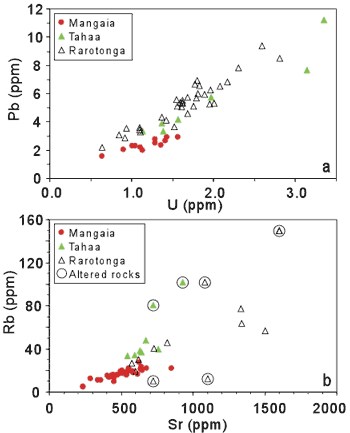
Figure 12: a) U-Pb and b)
Sr-Rb diagrams from Mangaia (Cook Island), Tahaa
(Society Island) and Rarotonga (Cook Island)
basalts which represent HIMU, EM1 and EM2 mantle
end-members respectively. Data for these different
oceanic islands are from GEOROC data base (http://georoc.mpch-mainz.gwdg.de/georoc/Start.asp).
Basalt analyses are considered to be altered
based on the Rb-Ba correlation defined by Hofmann
& White [1983], where the two elements were
analysed in the same sample or when the Rb/Sr
ratio seems unrealistic.
|
Rarotonga basalts do not
present the low 143Nd/144Nd observed
in Pitcairn basalts which are considered to be the melt
products of a near "pure" EM1 source. A hypothesis
for the decrease of Sm/Nd in the source of Pitcairn
basalts is the fractionation of garnet during the metasomatic
process which generates the differentiated veins (KdGarnet/liquidSm
> KdGarnet/liquidNd). Phlogopite
and garnet represent high pressure phases in alkaline
rocks. Thus, we propose that metasomatic formation of
the EM1 isotopic composition, rather than EM2, is linked
to the thickness of the lithosphere – thick for
the formation of EM1 (continental lithosphere?) and
thin for EM2 (oceanic lithosphere?). However, more studies
are necessary to investigate further these last suggestions.
4.2 Variation
of high field strength elements in HIMU and non-HIMU
ocean island basalt
In
the subducted oceanic crust hypothesis for the source
of OIB, enrichments in Ba, Rb, Th, U and La relative
to Nb and Ta in the EM1 and EM2 end-members, compared
to the HIMU source (Figures 10a and 10b), is ascribed
to recycling of pelagic (EM1) and terrigenous (EM2)
sediments into the mantle [Weaver, 1991; Chauvel
et al., 1992]. Following Kogiso et al.
[1997], this hypothesis is problematic for HIMU
and other OIBs in southern Polynesia. The major element
characteristics of those OIB magmas do not support significant
involvement of basaltic components in non-HIMU sources;
and the Nb enrichment of HIMU basalts relative to other
incompatible elements is difficult to explain simply
by the addition of a crustal component to the source
of HIMU rocks [Kogiso et al., 1997].
These inconsistencies are solved by the metasomatic
hypothesis presented here, where the high Nb/Th in HIMU
is explained by the presence of a small amount of Ti-rich
oxide in metasomatic veins. Ti-oxides have large distribution
coefficients (Kd) for HFSEs. Thus, low La/Nb, Ba/Nb,
Th/Nb and high Hf/Lu in the HIMU source is explained
by precipitation of Ti-oxide during modal metasomatism,
preferentially enriching Nb and Hf relative to other
incompatible elements in the lithospheric source. Hf
and Nd isotope ratios in non-HIMU OIB exhibit a strong
positive correlation (Figure 13), indicating a control
by magmatic processes [Salter & White, 1998;
Niu
& O'Hara,
2003]. HIMU basalts differ
from other basalts falling on the main OIB array in
that they have a low 176Hf/177Hf
value for a given 143Nd/144Nd,
reflecting a larger Hf/Lu ratio in their source. Even
if recycled subducted oceanic crust can duplicate the
Hf-Nd isotopic composition observed in HIMU basalts,
mixing the subducted residuum with sediments in the
mantle does not produce the main 176Hf/177Hf
- 143Nd/144Nd array for non-HIMU
OIBs [Salter & White, 1998]. Enrichment in
Hf relative to Lu in the HIMU source by modal metasomatism
before the evolution of the isotopic system explains
the Hf-Nd isotopic variation in all OIB sources more
simply (Figure 13).
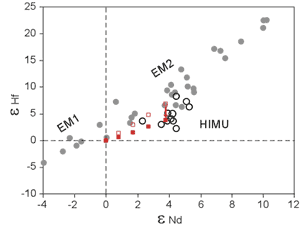
Figure 13: εHf vs εNd diagram for oceanic
basalts. εHf = (176Hf/177Hf(t,sample)/176Hf/177Hf(t,CH)
-1) x104 with 176Hf/177HfCH,today
=0.282772 [Blichert-Toft & Albaréde,
1997]. Filled grey circles: non-HIMU-OIB compositions;
open circles: HIMU-OIB compositions; data from
Salters & White [1998]. Open squares: evolution
of a hypothetical OIB mantle source after 2
Ga from an initial Bulk Silicate Earth isotopic
composition with 176Lu/177Hf
and 147Sm/144Nd
of 0.0381 and 0.2115
respectively. Filled squares: model mantle as
in open squares except with the addition of
0.01% of rutile. Hf concentration in rutile
= 340 ppm [Kalfoun et al.,
2002]. Arrow shows the
effect on εHf (decrease of ~3.0) in non-HIMU basalts by the addition of 0.01% of
rutile. This decrease is equivalent to the observed
difference in εHf between
HIMU and non-HIMU basalts.
|
|
5.
Summary
5.1 General
-
Variations in the
chemical compositions of Cantal basalts are interpreted
as the result of a metasomatic agent within the
lithosphere. The Cantal example demonstrates that
basalts characterized by OIB chemical compositions
could be generated by partial melting of metasomatic
veins plus enclosing lithospheric mantle. Such a
heterogeneous source may form within either the
continental or oceanic lithosphere.
-
The
evolution of the metasomatic
agent could generate trace element variations (U/Pb, Th/Pb, Rb/Sr, Sm/Nd, Nb/La etc.) in
different parts of the lithosphere. Isolation of
this metasomatic lithosphere would generate isotopic
and trace element ratio variations that are similar
to the variations observed in oceanic islands. These
observations are compelling evidence that variable
isotopic and trace element ratio signatures in the
mantle sources of single oceanic islands can be
produced by subduction of metasomatised oceanic
lithosphere or delamination of metasomatised continental
lithosphere.
-
The similarity between
the trace element variation observed in Cantal basalt
and the variation observe between Mangaia (HIMU)
and Tahaa (EM2) - Rarotonga (EM1) islands suggest
that model HIMU and EM end-member isotopic and chemical
compositions could correspond to the extreme trace-element
fractionation generated by metasomatic process within
the lithosphere.
5.2
Implications for the existence of plumes
-
The new interpretation
of OIB sources proposed here requires re-evaluation
of the processes that control the chemical evolution
of Earth's mantle reservoirs and their chemical
and isotopic indicators.
-
The metasomatic
hypothesis is entirely consistent with the isotopic
heterogeneity observed in the source of oceanic
basalts and experimental data which indicate that
the most plausible source of OIB material are pyroxenites
[ Hirschmann
et al.,
2003; Kogiso et al., 2003]. This model
is particularly interesting for the formation of
high-silica undersaturated rocks as nephelinite
or basanite where the common interpretation as recycled
oceanic crust clearly fails to explain their major
element composition.
-
Recycled metasomatised
lherzolite may be the major mantle source sampled
by OIBs; recycled oceanic crust and sediment may
be less common in OIB sources than is usually assumed.
-
The addition of
volatiles, in particular of CO2, to lherzolite
significantly decreases the solidus temperature.
The metasomatic model for the origin of OIB suggests
that OIB could be produce at a lower temperature
than is commonly assumed in the recycled oceanic
crust model.
|
Acknowledgements
We are
grateful for long discussions with Mike O'Hara and Yaoling
Niu. We also thank D. Fontignie, A. Potrel, M. Poujol,
J. Kramers, B. Villemant, M. Tubrett and L. Hewa for
help with TIMS, INAA, MC-ICP-MS and laser ablation ICP-MS
analyses. |
References
-
F. Albarede, How
deep do common basaltic magmas form and differentiate?,
J. Geophys. Res., 97 (1992) 10,997-11,009
-
J.A.
Baker, C.G. Macpherson,
M.A. Menzies, M.F. Thirlwall, M. Al-Kadazi, D.P.
Mattey, Resolving crustal and mantle contributions
to continental flood volcanism, Yemen: Constraints
from mineral oxygen isotope data, J. Pet.,
41 (2000) 1805-1820
-
R.M. Bedini,
J.L. Bodinier, J.M. Dautria and L. Morten, Evolution
of LILE-enriched small melt fractions in the lithospheric
mantle: A case study from the East African rift:
Earth Planet. Sci. Lett., 153
(1997) 67-83
-
J. Blichert-Toft,
F. Albarede, The Lu-Hf isotope geochemistry of chondrites
and evolution of the mantle-crust system, Earth
Planet. Sci. Lett., 148 (1997) 243-258
-
C. Chauvel, A.W.
Hofmann, P. Vidal, HIMU-EM; the French Polynesian
connection, Earth Planet. Sci. Lett., 110
(1992) 99-119
-
G. Dobosi, G.A.
Jenner, Petrologic implications of trace element
variation in clinopyroxene megacrysts from Nógrád
volcanic province, north Hungary: a study by laser
ablation microprobe-inductively coupled plasma-mass
spectrometry, Lithos, 46 (1999) 731-749
-
J. Dostal, B.L.
Cousens, C. Dupuy, The incompatible element characteristics
of an ancient subducted sedimentary component in
ocean island basalt from French Polynesia, J.
Pet., 39 (1998) 937-952
-
H. Downes, M.K.
Reichow, P.R.D. Mason, A.D. Beard, M.F. Thirlwall,
Mantle domains in the lithosphere beneath the French
Massif Central: trace element and isotopic evidence
from mantle clinopyroxenes, Chem.
Geol., 200 (2003) 71-87
-
C. Dupuy, H.G. Barsczus,
J. Dostal, P. Vidal, J.-M. Liotard, Subducted and
recycled lithosphere as mantle source of ocean island
basalts from southern Polynesia, central Pacific,
Chem. Geol., 77 (1989) 1-18
-
J.M. Eiler, K.A.
Farley, J.W. Valley, E. Hauri, H. Craig, S.R. Hart,
E. Stolper, Oxygen isotope variations in ocean island
basalt phenocrysts, Geochim. Cosmochim. Acta,,
61 (1997) 2281-2293
-
M. Granet, M. Wilson, U. Achauer, Imaging a mantle plume beneath the French
Massif Central, Earth Planet. Sci. Lett.,
136
(1995) 281-296.
-
T.H. Green,
D.H. Green, A.E. Ringwood, 1967, The origin of high-alumina
basalts and their relationships to quartz tholeiites
and alkali basalts, Earth
Planet. Sci. Lett., 2 (1967) 41-51
-
-
S.R. Hart, E.H.
Hauri, L.A. Oschmann, J.A. Whitehead, Mantle plumes
and entrainment; isotopic evidence, Science,
256 (1992) 517-520
-
B.
Harte, R.H. Hunter, P.D. Kinny, Melt geometry, movement
and crystallization, in relation to mantle dykes,
veins and metasomatism, Phil.
Trans. Royal Soc. London, Series A, 342
(1993) 1-21
-
-
E.H. Hauri,
S.R. Hart, Re-Os isotope systematics of HIMU and
EMII oceanic island basalts from the south Pacific
ocean, Earth
Planet. Sci. Lett., 114 (1993) 353-371
-
-
A.W
Hofmann and S.R. Hart, An assessment of local and
regional isotopic equilibrium in the mantle Earth Planet. Sci. Lett., 38 (1978) 44-6
-
A.W.
Hofmann, W.M. White, Mantle plumes from ancient
oceanic crust, Earth Planet. Sci. Lett., 57 (1982) 421-436.
-
A.W. Hofmann, W.M.
White, Ba, Rb and Cs in the Earth's Mantle, Zeitschrift
für Naturforschung, 38a (1983) 256-266
-
K. Hoernle, Y.S.
Shang, D. Graham, Seismic and geochemical evidence
for large-scale mantle upwelling beneath the eastern
Atlantic and Western and Central Europe, Nature,
374 (1995) 34-30
-
K.P. Jochum, B.
Sarbas, A.W. Hofmann, Characterizing OIB mantle
sources by trace element ratios using the GEOROC
Database, GERM, workshop 2001, La Jolla,
Abstract, (2001) B22-B24
-
F. Kalfoun,
D. Ionov, C. Merlet, 2002, HFSE
residence and Nb/Ta ratios in metasomatised, rutile-bearing
mantle peridotites, Earth Planet. Sci. Lett., 199 (2002)
49-65
-
S. Keshava, G. H.
Gudfinnsson, G. Sen, Y. Fei, High-pressure melting
experiments on garnet clinopyroxenite and the alkalic
to tholeiitic transition in ocean-island basalts,
Earth Planet. Sci. Lett., 223 (2004)
365-379
-
T. Kogiso, Y. Tatsumi,
G. Shimoda, H.G. Barsczus, High m
(HIMU) ocean island basalts in southern Polynesia:
new evidence for whole mantle scale recycling of
subducted oceanic crust, J. Geophys. Res.,
102 (1997) 8085-8103
-
T.
Kogiso, K. Hirose, E. Takahashi, Melting experiments
on homogeneous mixtures of peridotite and basalt:
application to the genesis of ocean island basalts,
Earth Planet. Sci.
Lett., 162 (1998) 45-61.
-
T. Kogiso, M. M.
Hirschmann, D. J. Frost, High-pressure partial melting
of garnet pyroxenite: possible mafic lithologies
in the source of ocean island basalts, Earth
Planet. Sci. Lett., 216 (2003) 603-617.
-
T. Kogiso, M.M.
Hirschmann, P.W. Reiners, Length scales of mantle
heterogeneities and their relationship to ocean
island basalt geochemistry, Geochim. Cosmochim.
Acta, 68 (2004) 345-360
-
X. Lenoir,
C.J. Garrido, J.-L. Bodinier, J.-M. Dautria, Contrasting
lithospheric mantle domains beneath the Massif Central
(France) revealed by geochemistry of peridotite
xenoliths, Earth Planet. Sci. Lett., 181 (2000) 359-375
-
X. Lenoir, C.J.
Garrido, J.L. Bodinier, J.M. Dautria and F. Gervilla,
The recrystallization front of the Ronda Peridotite:
Evidence for melting and thermal erosion of subcontinental
lithospheric mantle beneath the Alboran Basin, J.
Pet., 42 (2001) 141-158
-
C.C. Lundstrom,
J. Gill, Q. Williams, A geochemically consistent
hypothesis for MORB generation, Chem. Geol.,
162 (2000) 105-126
-
D. McKenzie, K.R.
O'Nions, The source regions of ocean island basalts,
J. Pet., 36 (1995) 133-159
-
Y. Nakamura, M.
Tatsumoto, Pb, Nd and Sr isotopic evidence for a
multicomponent source for rocks of Cook-Austral
islands and heterogeneities of mantle plumes, Geochim.
Cosmochim. Acta, 52 (1988) 2909-2924
-
Y. Niu, D.G. Waggoner,
J.M. Sinton, J.J. Mahoney, Mantle source heterogeneity
and melting processes beneath seafloor spreading
centres: the East Pacific Rise, 18¾ – 19¾S,
J. Geophys. Res., 101 (1996) 27711-27733
-
Y. Niu, R. Batiza,
Trace element evidence from seamounts for recycled
oceanic crust in the eastern Pacific mantle, Earth
Planet. Sci. Lett., 148 (1997) 471-483
-
-
-
-
-
M. Rehkämper,
A.W. Hofmann, Recycled ocean crust and sediment
in Indian Ocean MORB, Earth Planet. Sci. Lett.,
147 (1997) 93-106
-
A.E. Saal, S.R.
Hart, N. Shimizu, E.H. Hauri, G.D. Layne, Pb isotopic
variability in melt inclusions from oceanic island
basalts, Polynesia, Science, 282 (1998)
1481-1484
-
V.J.M. Salters,
W.M. White, Hf isotope constraints on mantle evolution,
Chem. Geol., 145 (1998) 447-460
-
S.S.
Sun, W.F. McDonough, Chemical and isotopic systematics
of oceanic basalts; implications for mantle composition
and processes, in A.D. Saunders and M.J.
Norry, eds., Magmatism in the oceanic basins.
Geological Society of London Spec. Pub. 42 (1989) 313-345
-
Cs.
Szabo, R.J. Bodnar, Fluid-inclusion
evidence for an upper-mantle origin for green clinopyroxenes
in late Cenozoic basanites from the Nógrad-Gömör
volcanic field, northern Hungary, southern Slovakia,
in Snyder, G.A., et al., Planetary
petrology and geochemistry, The Lawrence A. Taylor
60th birthday volume, Columbia, Bellwether Publishing
(1999) 83-91.
-
G.M. Thompson, I.E.M.
Smith, J.G. Malpas, Origin of oceanic phonolites
by crystal fractionation and the problem of the
Daly gap: an example from Rarotonga, Contrib. Min.
Pet., 142 (2001) 336-346
-
S.Y. Wass, Fractional
crystallization in the mantle of late-stage kimberlitic
liquids – Evidence in xenoliths from Kiama
area, N.S.W., Australia, in Boyd, F.R., and
Meyer, H.O.A., eds., The mantle sample: Inclusion
in kimberlites and other volcanics:
Washington, Am. Geophys. Union. (1979) 366-373
-
B.L.
Weaver, The origin of ocean island end-member compositions:
trace element and isotopic constraints, Earth
Planet. Sci. Lett., 104 (1991) 381-397
-
W.M. White, R.A.
Duncan, Geochemistry and geochronology of the Society
Islands: new evidence for deep mantle recycling,
in A. Basu and S.R. Hart, eds, Earth processes,
reading the isotopic code. AGU, Washington DC:
Geophysical monograph, 95 (1996) 183-206
-
W.M. White, Sources
of oceanic basalts: Radiogenic isotopic evidence,
Geology, 13 (1985) 115-118
-
R.K. Workman, et
al., Recycled metasomatized lithosphere as the
origin of the Enriched Mantle II (EM2) end-member:
evidence from the Samoan volcanic chain, Geochem.
Geophys. Geosysems, 5 (2004)
2003GC000623
-
M.
Wilson, H. Downes, Tertiary-quaternary extension-related
alkaline magmatism in western and central Europe,
J. Pet., 32 (1991) 811-849
-
E. Wulff-Pederson,
E.-P. Neumann, R. Vannucci, P. Bottazzi, L. Ottolini,
Silicic melts produced by reaction between peridotite
and infiltrating basaltic melts: ion probe data
on glasses and minerals in veined xenoliths from
La Palma, Canary Islands, Cont. Min. Pet.,
137 (1999) 59-82.
-
G.M. Yaxley, D.H.
Green, Reactions between eclogite and peridotite:
mantle refertilisation by subduction of oceanic
crust, Schweitz. Mineral. Petrogr. Mitt.,
78 (1998) 243-255
-
N.A.
Zangana, H. Downes, M.F. Thirlwall, G.F. Marriner,
F. Bea, Geochemical variation in peridotite xenoliths
and their constituent clinopyroxenes from Ray Pic
(French Massif Central); implications for the composition
of the shallow lithospheric mantle, Chem.
Geol., 153 (1999) 11-35
-
A. Zindler, S.R.
Hart, Chemical geodynamics, Ann. Rev. Earth Planet.
Sci., 14 (1986) 493- 571.
last updated 20th February,
2005 |
|
|
